A tsunami is a series of massive waves that occurs when a large amount of water is displaced. The term ‘tsunami’ comes from Japan and means ‘harbor wave’. Although sometimes referred to as tidal waves, tsunamis are not caused by tides.
In 2004, Tilly Smith, who was just 10 years old at the time, was at Maikhao Beach in Phuket, Thailand with her parents. She noticed that the sea suddenly became frothy and appeared to be bubbling. Remembering what she had learned about tsunamis in school, she warned her parents that a tsunami was coming. A few minutes later, a tsunami did hit the beach, but Tilly, her parents, and many other tourists had managed to escape. (Source)
 Tilly Smith (Photo Credit: ABCnews.com)
Tilly Smith (Photo Credit: ABCnews.com)
Having knowledge about natural disasters and how they work can help you identify warning signs and make critical decisions that could save your life and the lives of others. In this post, we will explore one of the most deadly natural disasters – tsunamis. What are they and how do they create waves that are fast, massive, and destructive?
What Exactly is a Tsunami?
 Tsunami: An artist’s impression (Photo Credit: Amanda Carden / Shutterstock)
Tsunami: An artist’s impression (Photo Credit: Amanda Carden / Shutterstock)
A tsunami is a series of gigantic waves caused by the displacement of a large volume of water, usually in the ocean. The term ‘tsunami’ comes from Japan and means ‘harbor wave’. Despite being sometimes called tidal waves, tsunamis are unrelated to tidal activity, which is responsible for waves in the ocean due to gravitational forces from the sun and moon.
Tsunamis vs. Regular Waves
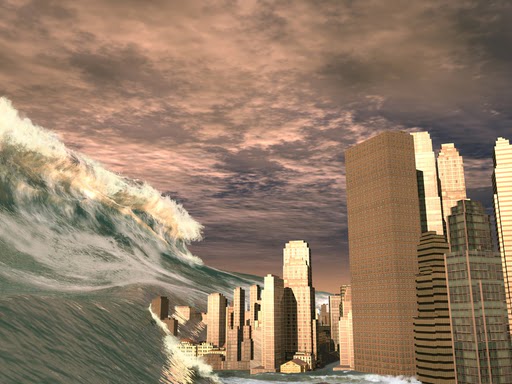 Tsunamis are incredibly massive and equally devastating (Photo Credit: Esteban De Armas / Shutterstock)
Tsunamis are incredibly massive and equally devastating (Photo Credit: Esteban De Armas / Shutterstock)
Tsunami waves share certain characteristics with regular waves, such as having a crest and a trough (the basic features of any wave) and transmitting energy through water. The difference lies in the source of energy. Regular waves are generated by wind interacting with the surface layer of water, resulting in small and relatively slow waves. However, tsunamis gather energy from various sources, including earthquakes on the ocean floor (the most common cause), underwater volcanic eruptions, or submarine landslides. These events displace large amounts of water rapidly, transferring energy to the water at a rate that exceeds its absorption capacity.
Stages Of A Tsunami
Generation
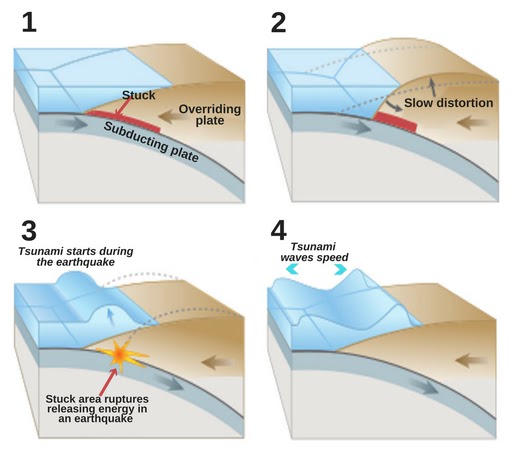 Tsunamis are most commonly caused by underwater earthquakes. When tectonic plates beneath the ocean’s surface slip past each other, a large amount of energy is released. This energy travels to the surface and displaces a significant volume of water. As the water is displaced, it rises above the surface and is pulled back down by gravity, creating multiple waves that spread across the surface.
Tsunamis are most commonly caused by underwater earthquakes. When tectonic plates beneath the ocean’s surface slip past each other, a large amount of energy is released. This energy travels to the surface and displaces a significant volume of water. As the water is displaced, it rises above the surface and is pulled back down by gravity, creating multiple waves that spread across the surface.
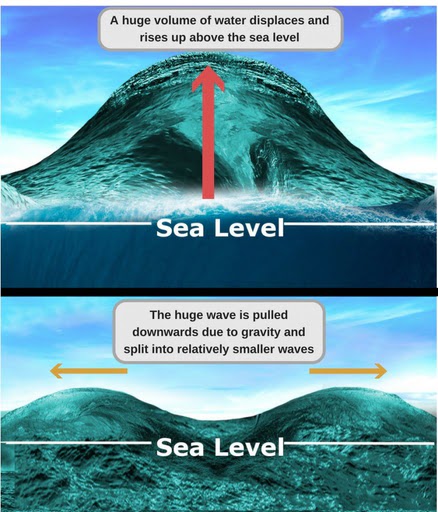 The displacement of large volumes of water leads to the formation of tsunami waves.
The displacement of large volumes of water leads to the formation of tsunami waves.
Propagation
Once tsunami waves are generated, they travel in all directions, similar to ripples spreading from a stone dropped in water. These waves can travel at speeds exceeding 900 kilometers per hour (550 mph). Tsunami waves have a very long wavelength, especially in deep water. The rate at which a tsunami loses its energy is inversely proportional to the wavelength of the waves.

Tsunami waves can have wavelengths as long as 500 kilometers (300 miles), resulting in minimal energy loss. This allows tsunami waves to travel at high speeds without being noticed over deep waters, where there is limited energy loss.
Inundation
However, as tsunami waves approach shallow waters near the shore, they undergo a rapid transformation. Due to the decrease in water depth, the rate of energy change becomes significant, causing an increase in wave amplitude. In other words, the energy becomes compressed as it has less water to move through, resulting in slower and taller waves, reaching heights of up to 100 feet. This phenomenon is known as wave shoaling.
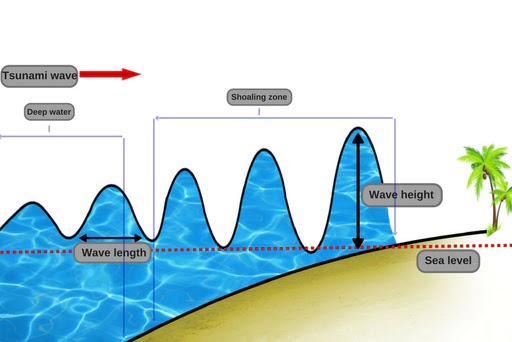 Wave shoaling: The height of the waves increases as they approach the shore.
Wave shoaling: The height of the waves increases as they approach the shore.
As a result of wave shoaling, tsunami waves that were almost undetectable in deep water can rise to terrifying heights near the shore. These waves are often referred to as “harbor waves” because they are only noticeable when they approach the shore, making evacuation challenging. Additionally, if the trough of the tsunami wave reaches the shore first, it can cause significant devastation, as the water recedes further than usual before returning with a powerful, towering wave that crashes inland.
Here is an interesting Ted-Ed video explaining the science behind tsunamis:
A significant number of tsunamis have occurred throughout history, causing unimaginable loss of life and property.
Dealing With Tsunamis
Identifying a Tsunami Wave
Tsunami waves are enormous, but they only become visible when they are near the shore. Therefore, it is important to look for other signs of warning. One indicator is when the water recedes from the coast, revealing the ocean floor, reefs, and fish. Survivors of tsunamis worldwide often mention hearing a “sucking” sound before the waves hit the beach. Unusual occurrences like waves creating a loud “roaring” sound similar to a jet and excessive frothiness also suggest an abnormally high wave.
Actions to Take During a Tsunami
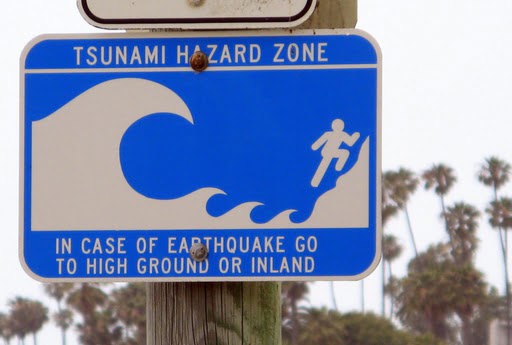 A Tsunami hazard zone sign (Photo Credit: Wikimedia.org)
A Tsunami hazard zone sign (Photo Credit: Wikimedia.org)
The best chance of surviving a tsunami is to quickly move to higher ground. It is crucial to avoid low-lying areas and create as much distance as possible between yourself and the wave. Contrary to popular belief, the first tsunami wave is not always the highest, so it is important to keep climbing even after the initial wave hits. Evacuate the impact area as soon as possible.
Predicting Tsunamis
Science cannot accurately predict when a tsunami will occur. However, through historical data and statistical modeling, it is possible to identify areas that are prone to these terrifying phenomena. Once detected, science can help determine the timing, severity, and impact area of tsunami waves, which aids in organizing evacuation efforts.
Tsunamis are among the deadliest displays of the formidable and unforgiving forces of nature. There is little that can be done to fight or defend against a tsunami. The best course of action is to remain aware of these events and move out of harm’s way when the deadly waves strike.
